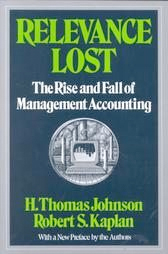 If you are at all interested in accounting I recommend the book Relevance Lost by Thomas Johnson and Robert Kaplan. I think it is a fascinating background to how we ended up with the kind of finance departments we have, but I admit it might be a minority interest. I had a girlfriend once who was in finance and I couldn’t even interest her in reading my copy.
If you are at all interested in accounting I recommend the book Relevance Lost by Thomas Johnson and Robert Kaplan. I think it is a fascinating background to how we ended up with the kind of finance departments we have, but I admit it might be a minority interest. I had a girlfriend once who was in finance and I couldn’t even interest her in reading my copy.
Although published in 1991 it is still in print. It covers how accounting used to be useful to managers, starting with New England mill owners in the 19th century. However, as the accounting rules and processes were hijacked by financial accounting they have become steadily more and more useless for managing the business. Nobody wants to keep multiple sets of books so managers try and manage using accounts put together for financial accounting reasons on a timescale driven by financial accounting deadlines.
The situation is even more disconnected in the case of a software or design company. Much of the real value of the company is bound up in partially or completed software products (or designs). The rules for capitalizing development are so strict that it must only be done when the product is pretty much released. Almost all the development is written off as an expense as if it were part of the utility bill, as opposed to an investment building up value in the company. From a point of view of keeping the tax paid by the company low this may be desirable; from the point of view of the balance sheet giving a useful assessment of the company not so much. Design Compiler is clearly a major asset of Synopsys but you won’t find it on the balance sheet anywhere, either as an estimate of its value as a forward looking business or even as a rollup of the cost of development over the years.
Other intangible assets, such as an effective high-skilled development team, appear nowhere. If a key employee leaves the value of the company may well have changed in a meaningful way but this is nowhere reflected. It is completely unclear how one would actually account for this in any sensible way, of course, but it sort of happens anyway. Look at the change in market cap of Apple when Steve Jobs is thought to be sick or not, which is actually the value of the asset of having Jobs as CEO that in principle should be on the balance sheet somewhere.
Software companies seem to have very lax financial controls in my experience. I worked for over ten years at VLSI Technology, a semiconductor company. That is a business in which a lot of money flows around but the margins are thin. Fabs cost (today) billions of dollars so getting the accounting right is important. The financial controls and forecasting in a semiconductor company are generally very good. When we spun Compass out we were still consolidated into VLSI’s books and we kept the finance we were used to. Every manager did an expense forecast for 6 months ahead, and monthly we looked at variances to that and were expected to explain them. Startups are small enough that their financial controls, at least for cash, are usually pretty good. But when I got to Cadence I was surprised that even as the manager of the custom IC business unit (then a $250M/year business) I wasn’t expected to forecast my expenses, it was hard to even find out what they were, and as a result they were pretty much whatever they turned out to be. The concept of over-spending didn’t exist. I assume that has changed somewhat now that the financial outlook is less rosy, but that sort of thing is part of the DNA of a company and is actually quite hard to change.
